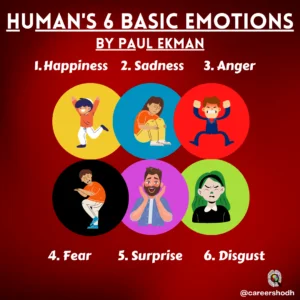The word emotion is derived from the Latin word ‘mot’ which means ‘to move’. In this article we will go through the 6 Basic Emotions by Paul Ekman. Emotions are an important and inevitable part of human being. Let us get familiar with the definition of Emotion and other terms.
Definition of Emotions
Buck defined emotion is a process by which motivational potential is realized or read out by activating a challenging stimulus.
American Psychological Association (APA) says – emotion is a complex reaction pattern, involving experiential, behavioral, and physiological elements, by which an individual attempts to deal with a personally significant matter or event.
Basically, emotion defines itself as the “feeling” aspect of consciousness, characterized by three elements: a certain physical arousal, a certain behavior that reveals the feeling to the outside world, and an inner awareness of the feeling.
What are Basic Emotions?
Energy in motion is an emotion. It is a way of expressing oneself in life. Emotions cannot be considered as good and bad as each emotion has a specific role to play in coloring our life. Emotions expressed by humans can be divided into two broad categories and are called as positive and negative emotions.
In positive emotions, an intention to include is expressed. They are fueled by an underlying desire for enjoyment and unity. Interest, enthusiasm, laughter, empathy, action, curiosity are the examples of positive emotions.
Similarly, in negative emotions an attempt or intention to exclude is expressed. They are fueled by an underlying fear of the unknown, a fear of the actions of others, and a need to control them or stop them to avoid being harassed. Apathy, grief, fear, hatred, shame, blame, regret, resentment, anger, hostility are examples of negative emotions.
Hence, the negative emotions are helpful and act as a motive in moving away from what one doesn’t want and positive emotions are useful for moving towards what one wants.

6 Basic Emotions by Paul Ekman – careershodh
6 Basic Emotions by Paul Ekman
Paul Ekman is an American psychologist who did extensive research on human emotions. His work showed that there are six basic human emotions seen in all cultures.
- Happiness
- Sadness
- Anger
- Fear
- Surprise
- Disgust

6 Basic Emotions by Paul Ekman
1. Happiness
Happiness is the most positive emotion which we all experience. It has association with satisfaction, contentment and joy. In addition, it has close connection with our psychological well being, health and longevity.
For example, Riya will experience happiness as her friends are giving her a surprise birthday party. Similarly, Raju is happy to play his favorite toy.
Shades of happiness are –
- joy
- relief
- contentment
- bliss
- delight
- amusement
- pride
- sensual pleasure
- thrill
- rapture
- gratification
- satisfaction
- euphoria
- whimsy
- ecstasy
- mania.
2. Sadness
Sadness is characterized by feelings like disappointment, grief and hopelessness. As we experience happiness, likewise, we also experience sadness from time to time. Although it’s very normal and natural to be sad at times, prolonged sadness can turn into depression. Of course there are some coping strategies to deal with our sadness which will make us more emotionally stable.
For example of Sadness – Rohan who recently experienced a break up will feel sad. Mona got her test results back, she has diabetes.
Shades of sadness are –
- grief
- sorrow
- cheerlessness
- gloom
- melancholy
- self-pity
- loneliness
- dejection
- despair
- depression
3. Anger
Anger is a very powerful emotion which includes hostility, agitation and frustration. It is often displayed through- facial expressions, body language, tone of voice and aggressive behavior. Anger is a two sided sword which can be good as well bad.
For example, Sameer will experience anger due to a disagreement with his friend. A child experiences anger when he/ she is hit.
Shades of Anger are –
- fury
- outrage
- resentment
- wrath
- exasperation
- indignation
- vexation
- acrimony
- animosity
- annoyance
- irritability
- hostility
- hatred
- violence
4. Fear
Fear is a powerful emotion which is closely related to our survival from the evolutionary point of view. It is also associated with fight or flight response because fear could indicate a threat.
For example, Sumi will experience fear as she will be scared to tell her parents that she has failed in her exam. Early humans experienced fear when they hunted animals.
Shades of Feat –
- anxiety
- apprehension
- nervousness
- concern
- consternation
- misgiving
- wariness
- qualm
- edginess
- dread
- fright
- terror
- phobia
- panic.
5. Surprise
Surprise is associated with a physiological state of response after some unexpected event. It can be positive. However, it can be negative or neutral also.
For example, when your teacher announces a surprise test in the class, that can be an unpleasant surprise for most of you ! However, Arun is pleasantly surprised after seeing his school best friend suddenly across the street. Emotion of surprise can sometime increase your adrenaline which will further prepare your body for fight or flight response.
Shades of surprise –
- shock
- astonishment
- amazement
- wonder
6. Disgust
Disgust is the state of disapproval for something unpleasant. Evolutionarily disgust evolved as a reaction to foods that might be harmful or fatal. So generally disgust is more common reaction to the taste or smell of stuff gone bad.
But some other unwanted situations may also give rise to disgust. People may also experience moral disgust when they observe others engaging into immoral behaviors.
For example, Amy is going to experience disgust as she reads the news of a gang rape.
Shades of Disgust –
- contempt
- distain
- scorn
- abhorrence
- aversion
- distaste
- revulsion
Nevertheless, human emotions are not so simple and sometimes we experience mixture of emotions which are complex to understand
Higher Cognitive Emotions
Following are some of the emotions which are like basic emotions and universal but the expression of these emotions vary across different cultures.
- Love
- Guilt
- Shame
- Embarrassment
- Pride
- Envy
- Jealousy
Criticism of 6 Basic Emotions by Paul Ekman
There are methodological criticisms of Ekman’s work. They throw light on the fact that his experiments were extremely tautological in nature. In those experiments, test subjects saw selected photographs of “basic emotions.” Further, asked to match them with the same set of concepts used in their production.
Ekman showed photographs selected from over 3000 pictures of individuals asked to simulate emotions. From which he edited to contain “those which showed only the pure display of a single affect,” using no control and subject only to Ekman’s intuition. If Ekman felt a photograph did not show the correct “pure” emotion, he excluded it.
Plutchik’s 8 basic or primary emotions.
According to Plutchik, there are eight basic or primary emotions. All other
emotions result from various mixtures of these basic emotions. He arranged these emotions in four pairs of opposites, i.e.

Plutchik’s model of emotions
- Joy-Sadness,
- Acceptance-Disgust,
- Fear-Anger,
- Surprise-Anticipation.
Plutchik’s model is important from the perspective of emotional literacy that is not only
having words for emotions but understanding how different emotions are related to one
another and how they tend to change over a period of time.
So we need to keep a watch on our emotions, name them appropriately and address them in a healthy way to avoid triggering them in the future.
Izard’s 10 basic Emotions
Izard has proposed a set of ten basic emotions, i.e.
- Joy,
- Surprise,
- Anger,
- Disgust,
- Contempt,
- Fear,
- Shame,
- Guilt,
- Interest,
- Excitement
with combinations of them resulting in other emotional blends
To check your understanding of the topic, solve this short test – MCQ Test – 6 Basic Emotions
References
- Ciccarelli, S. K.; White J. N. Adapted by Girishwar Misra (2018). Psychology (5th Edition). Pearson.
- egyankosh.ac.in
- Maharashtra State Bureau of Textbook Production and Curriculum Research, Pune. (2020)
Subscribe to Careershodh
Get the latest updates and insights.
Join 13,984 other subscribers!
Niwlikar, B. A. (2022, February 25). Popular Theory of the 6 Basic Emotions by Paul Ekman. Careershodh. https://www.careershodh.com/popular-theory-of-the-6-basic-emotions/
